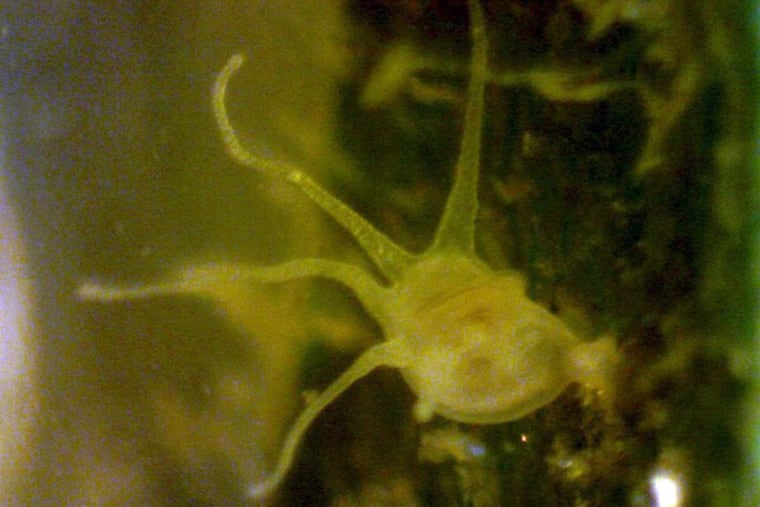Jellyfish threat in N.J. waters will persist, researchers say
Clinging jellyfish, a dime-size species with a horrific sting, are reproducing in Monmouth County's Shrewsbury River and "will almost certainly be a presence" there next year, according to researchers.

Clinging jellyfish, a dime-size species with a horrific sting, are reproducing in Monmouth County's Shrewsbury River and "will almost certainly be a presence" there next year, according to researchers.
"That's disturbing news," said Montclair State University biologist Jack Gaynor, because the Shrewsbury joins the Navesink River, which flows into Raritan Bay.
From there, he said, ocean currents could carry adults or their tiny spawn south into the Metedeconk and Manasquan Rivers, which connect to Barnegat Bay - a 42-mile stretch of water hugely popular with bathers and boaters in Central and South Jersey.
Gaynor is part of a research team searching several coastal waterways since June for signs of the new invader, whose acutely painful venom can induce organ failure in humans.
The team found adults in the Shrewsbury, Metedeconk, and Manasquan in June and July, but have not found any this month in the latter two rivers, Gaynor said this week, and noted they have "all but disappeared" from the Shrewsbury.
The adult population's collapse had led the team to speculate that sea nettles - a locally abundant jellyfish with a mild sting - might be eating the adult clinging jellies, he said, hoping they had been eradicated before they began to spawn.
But recent DNA tests revealed something alarming - a fertilized polyp found in the Shrewsbury on Aug. 3 was that of a clinging jelly.
"It's important to understand," Gaynor said, "that the polyps are the persistent phase in a jellyfish population" because they can wait years to emerge as adults.
Clinging jellies - so named because they cling to sea grass by day - prefer calm, shallow water and avoid ocean surf. Native to Asian Pacific coastal waters, they feed at night by dropping through water, capturing plankton with their long, filament-like tentacles.
State health officials were alerted to the presence of Gonionemus vertens in mid-June after a 20-year-old college student - stung while swimming at night in the shallow Shrewsbury - was admitted to a local hospital with racking muscle cramps, burning, redness, swelling, and edema.
"I thought I was going to die," Matt Carlo of Lincroft, Monmouth County, told interviewers after his two-day stay. Doctors had prescribed morphine to ease pain that he described as "like a charley horse in every muscle."
Carlo's symptoms were so suggestive of a clinging jelly's sting that the state Department of Environmental Protection swiftly contracted with Montclair State to search the Shrewsbury and nearby rivers for signs of them.
Using weighted traps of artificial sea grass that mimic the feeding habitat the jellies favor, the researchers found in late June that adults were relatively abundant in the Shrewsbury, and present to a lesser degree in the Manasquan and Metedeconk.
The latter rivers are connected by the fast-moving Point Pleasant Canal. The Metedeconk meets the northern tip of Barnegat Bay at Bay Head Harbor.
The Montclair State researchers have not set traps for clinging jellies in the bay, Gaynor said, because the DEP had asked them to focus on the northern rivers.
As it became evident in August that the adult population had "essentially disappeared," Gaynor and his colleague, biologist Paul Bologna, turned to the question of whether adults had spawned in the affected rivers.
Making that determination proved "very, very difficult," Gaynor, a genetic biologist, said this week, because the clinging jellies' fertilized polyps are less than a half-millimeter in size and visually indistinguishable from the polyps of many other marine species.
His laboratory did DNA tests on nearly 100 polyps from 15 different traps before discovering that the one pulled up Aug. 3 on the Shrewsbury's Blackberry Bay was G. vertens. "It was the proverbial needle in a haystack," he said.
Although the species is abundant along the Pacific coasts of Russia and China, and appeared on Cape Cod in Woods Hole, Mass., in 1894, "we don't know much about its ecology and life history," said Gaynor.
He and Bologna, director of Montclair State's marine biology and coastal sciences program, are preparing a paper on the New Jersey invasion, he said.
State health officials speculate the species might have been carried to New Jersey in the discharged ballast water of a ship from Asia, or on the hull of a vessel coming here from the vicinity of Woods Hole.
What scientists do know about clinging jellies' breeding pattern is not encouraging, however, since their capacity for reproducing is "fairly unlimited," Gaynor said.
Fertilized polyps can survive for several years in inhospitable conditions, and produce new generations either by generating bud-like clones of themselves or microscopic cysts, called ephyra, that can mature into adults.
But there is one ray of hope, he said. Tiny sea slugs, or nudibranchs, are abundant in New Jersey's inland waterways and are known to feed on the polyps of many species.
If they also feed on clinging jellies, Gaynor said, "that might be a potential form of control."
856-779-3841